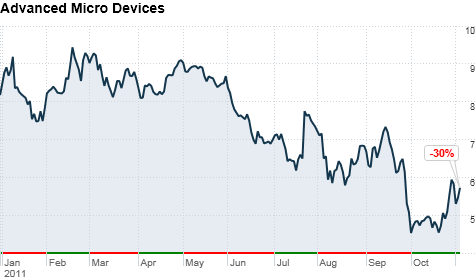
NEW YORK (CNNMoney) -- Microchip maker AMD, Intel's chief rival, announced Thursday that it would cut about 1,200 jobs in an attempt to get its costs under control.
The layoffs represent roughly 10% of AMD's 11,600 employees across the globe. AMD said it expects to see the benefits of the job cuts right away, gaining $10 million in savings during the current quarter and $118 million next year.
The company also said it would implement certain "operational efficiency initiatives" that will save an additional $90 million next year. It did not go into specifics about its plans.
The job cuts will cost AMD a little more than $100 million in the current quarter.
That still leaves the company financially ahead for the company year, with around $200 million freed up for reinvestment. AMD said it plans to use the cash to deepen its investment in new technologies like chips that use less power for mobile devices like tablets. It also intends to invest more in emerging markets around the world, and in cloud-based technologies.
Shares of AMD (AMD, Fortune 500), which rose slightly in after hours trading, have fallen by nearly 30% this year. Unlike Intel (INTC, Fortune 500), which has weathered this year's declining demand for personal computers, AMD has taken a direct hit. The company lowered its business outlook by about half in September due to demand concerns.
Still, AMD is operating profitably. It earned $668 million in the first nine months of 2011 on sales of $4.9 billion, a slight decline from its sales in the same timeframe a year earlier.
AMD is known for lighting-fast PC processors that are often more powerful than those of its much bigger rival, Intel. But the PC industry's biggest growth is in smaller, mobile devices that require power-sipping microchips that preserve battery life -- not exactly AMD's specialty.
The company is hoping to turn things around next year, as it begins to sell chips for Microsoft (MSFT, Fortune 500) Windows 8 tablets. Despite Microsoft's decision to open up the Windows platform to companies that run chips based on the rival ARM (ARM) platform that most smartphones use today, AMD believes it can provide the right combination of speed and battery preservation to improve its fortunes. ![]()